Last Chance to Catch NYC's Holiday Notalgia Train
We met the voices of the NYC subway on our nostalgia ride this weekend!


Marc Gordon, AIA, LEED®AP BD+C Partner, is a practicing architect in New York, where he’s a partner at the firm Spacesmith. A lifelong student of New York history, he’s an enthusiastic believer that the city’s past holds lessons for us all today. On weekends and in other snippets of free time, Marc traverses the boroughs exploring hidden history and seeking stories that he hopes will illuminate New York’s architectural heritage, inspire an appreciation for the richness of urban life, and give voice to the metropolis he calls home. He’s excited to share this piece with Untapped Cities readers.
There has been plenty of talk recently about the gentrification of New York. This is a dynamic city and it is often said that the only constant in New York is change. In the last 20 years, New York has transformed at an astonishing rate, and parts of the city are hardly recognizable from the gritty urban decline of the 1970’s and 80’s and subsequent turnaround in the 90’s. However, along with the positive aspects of economic growth come the negative side effects of rampant over development and loss of character that makes our city unique.
Much of the discussion in the news lately has been focused on the socio-economic impact of demographic changes, income inequality, rising real estate costs and the growing chasm between the wealthy and the poor. There is an ongoing political discourse regarding the Tale of Two Cities. These types of changes have happened in New York before and they will continue to happen in the future. In fact if you look carefully enough you can see past changes reflected in the buildings and neighborhoods throughout the city. For example, many commercial buildings around Wall Street are now residential, residential walk-up buildings in midtown south have been repurposed for stores and businesses and warehouses adapted for residential or mixed-use commercial. Although these changes have been occurring throughout the city, Manhattan is unique in the fact that tectonic changes to the urban fabric are not new here and have always occurred on a scale not seen in other boroughs, due in part to its density and situation as the city’s business center.
One aspect of recent developments includes the disintegration of many distinct commercial districts specializing in a particular service or type of business. Here are few that you may still be able to find and few that are gone forever. These districts lent a distinctive character to the urban context.
Music Row was located on 48th Street between 6th & 7th Ave. If you were a musician in New York City, this area was the place to go. Whether it was rock & roll, R & B, punk, classical, Jazz or whatever, this once thriving block was a one stop shopping for any instrument, sheet music and instrument repair. Music shops including several from Sam Ash specializing in different instruments, Alex Musical Instruments, New York Woodwind and Brass, Rudy’s Music Stop and Manny’s, lined both sides of the street…there was plenty to choose from.
The location of Music Row was probably due to its proximity to Times Square, Radio City Music hall, the Brill Building and the recording studios and record companies on 6th Avenue. The music shops are now all gone leaving empty storefronts ready for the wrecker’s ball.
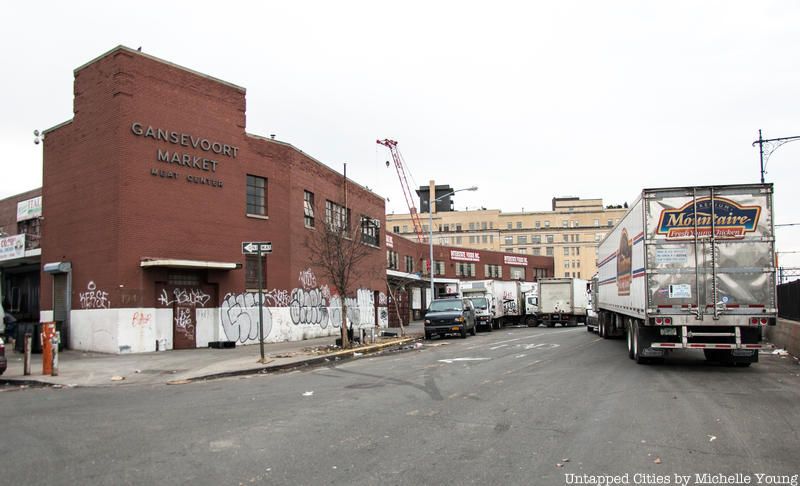
The Meatpacking District, located west of 9th Avenue and south of 14th Street, once housed 250 slaughterhouses and packing plants. By 1930 it produced the third largest volume of dressed meats in the country. With containerization of freight and proliferation of supermarkets, the meat packing business began to decline. However, business continued with subsidies from the city. The areas started to transition in the 90’s and now most of the meat packing businesses have been pushed out by soaring rents and displaced by high end boutiques, nightclubs and restaurants. Most have relocated to Hunts Point in the Bronx, but a few still exist adjacent to the new Whitney Museum.
Check out photographs of the Meatpacking District in the 1990s by photographer Gregoire Alessandrini.
https://https://www.youtube.com/watch?v=-Wl9zhC-snY
Bookseller’s or Book Row was an area of used book stores located on 4th Avenue from 8th Street to 14th Street that had 48 bookstores. This mecca for second hand books started in the 1890’s and lasted until the late 1960’s. The secondhand book business was not lucrative and many stores moved or went out of business when rents started to rise.
Strand bookstore which was originally on 4th Ave. is the largest survivor and has been located on Broadway and 12th Street since the late 50’s. While not an original to Booksellers’ Row, Alabaster Bookshop on 4th Avenue off 12th Street links the present to the past as the only used bookshop on 4th Avenue.
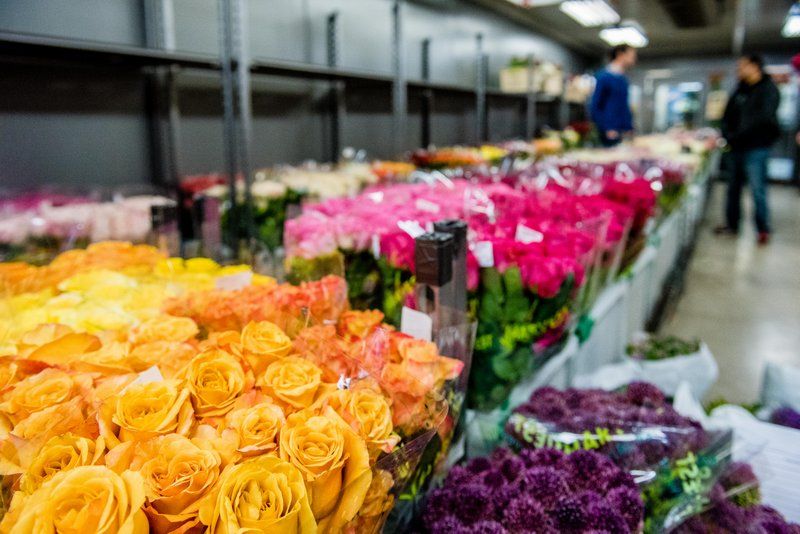
Photograph by Louis Brunet
The Flower District is located on 28th Street between 6th & 7th Avenues. This area became a magnet for flower and plant businesses likely due to its proximity to Midtown, Madison Square Garden and Macy’s, all a driving force behind recent low cost hotel development. Walking along this stretch of 28th Street among a colorful display of flowers and variety of other plants is a unique experience in this congested area of the city. Unfortunately it has become a popular alternative to higher priced lodging in Times Square. There are still some flower and plant suppliers hanging on, but hotel development is continuing. Check out one shop, Ode à la Rose, for French-style hand tied bouquets with easy ordering and delivery (including to Brooklyn).
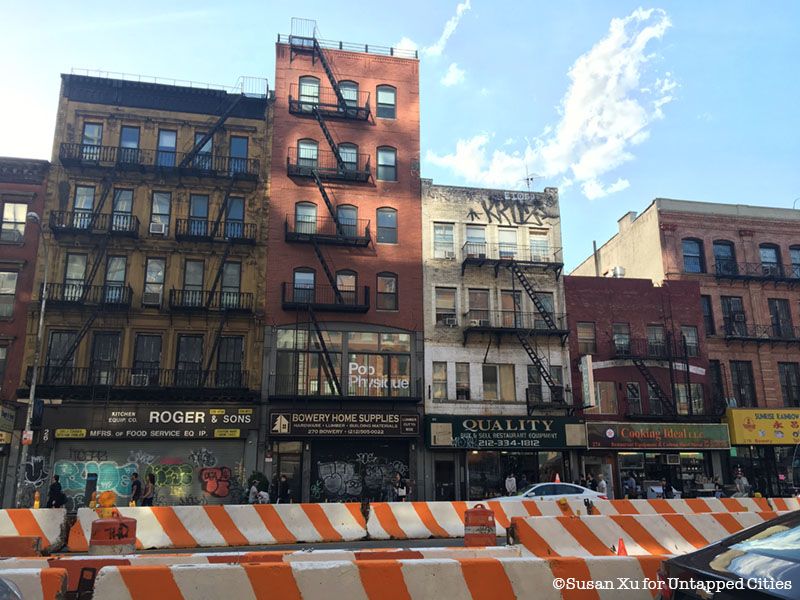
The Kitchen Restaurant Supply District is located on the Bowery between Houston and Canal. The Bowery is the oldest thoroughfare in Manhattan and was once one of New York’s most elegant streets. However, after the Civil War, the neighborhood changed with beer gardens, flop houses, pawn shops and brothels. After the great depression, the Bowery became New York’s Skid Row. In the late 40’s the area started to get an influx of restaurant supply and lighting stores.
This was the area where some of New York’s greatest chefs would shop to supply their restaurants. The shops are now being supplanted with hip hotels and large scale development including a Whole Foods and the New Museum. Luckily a large section of the Bowery was landmarked saving some of the fantastic architecture from the wrecking ball. The Kitchen Supply Stores are primarily above Delancey and the Lighting Supply Stores are below.
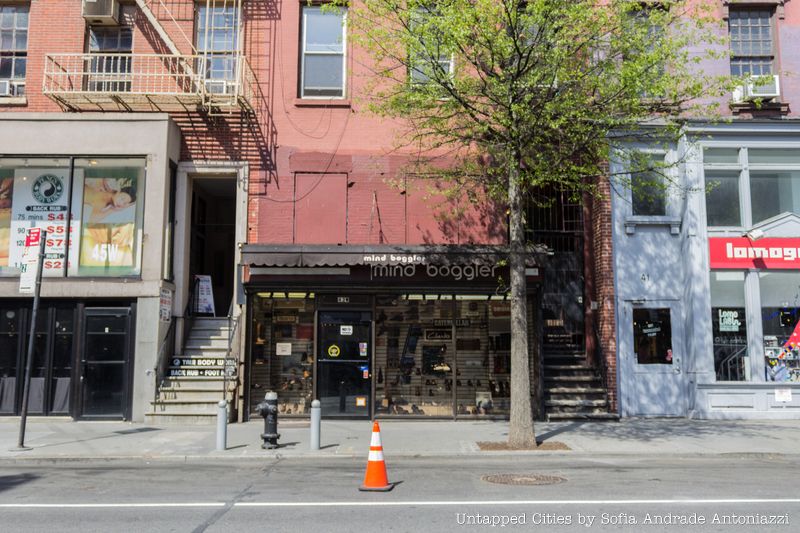
Shoe Row was an area of 8th Street between 5th and 6th Avenues that housed many mom and pop shoe stores. This was a bonafide footwear destination with over two dozen shoe stores mostly catering to the younger clientele that began to take off in the 1980’s. However, the local business improvement district initiated a transformation of this area a few years back as a nightlife destination. It wants to attract restaurants and nightclubs to harken back to its roots in the 1960’s as a gateway to the West Village, when coffee shops and bookstores attracted beatniks and hippies. Most of the shoe businesses have left due to rising rents and lack of customers.
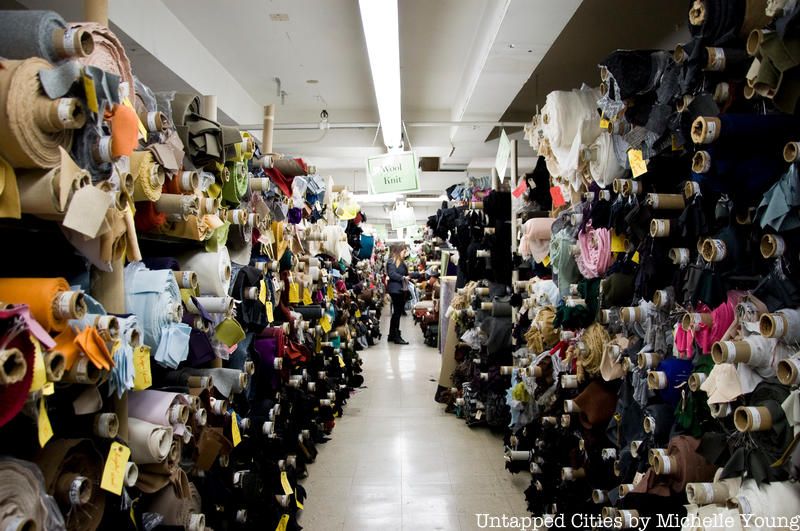
The Garment District occupies one square mile between 35th & 40th Street west of 5th Avenue. New York is known as one of the world’s fashion capitals so it makes sense that it has a vibrant Garment Center. In the 1950’s, factories in this district made 95% of the clothing sold in the U.S. and employed over 200,000 people, now it makes 3% and employs about 21,000 people.
The Garment Center still houses many garment businesses, showrooms and retail stores, but the area saw a steep decline in garment manufacturing due to outsourcing of manufacturing overseas, leading to the City designating the area as a Special Zoning District. However, the encroachment of luxury hotels and spillover businesses from Times Square are pushing out many of the garment businesses.
Rising real estate costs, the influx of national chains and changing shopping habits and demographics have all had a devastating impact on these unique districts. Most of them are gone leaving behind a blank slate for the developers to come in and put up condos, bank branches and national chain stores. In their wake the city is less diverse, less exciting and a less special place. The scale and variety of these districts added to the character of the city, regardless if you’ve ever bought an instrument on Music Row, or a Plant in the Plant district, you knew they were there.
New York is defined by its neighborhoods and districts; it is what helped make New York into a place that has drawn the best and brightest from around the world to visit, live, work and play here. If we continue on our current path to a corporate, banal and generic future, New York will be indistinguishable from other places.
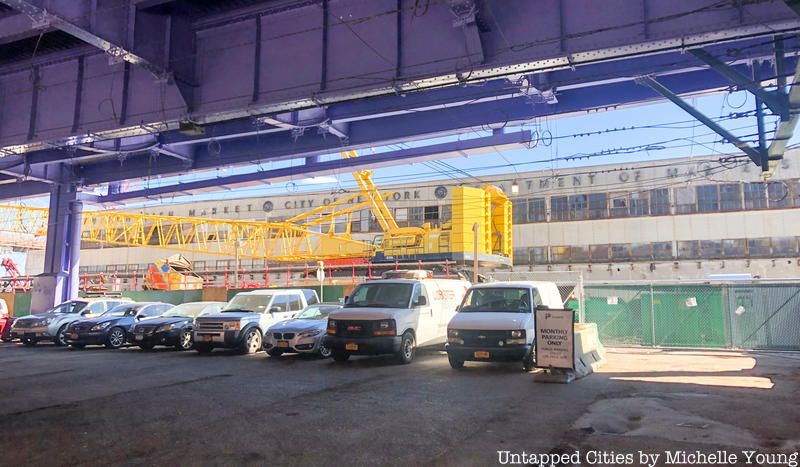
Fulton Fish Market undergoing demolition
The Fulton Fish Market was one of the largest wholesale fish markets on the east coast. Started in 1822, at South Street, fish were delivered by boat right to the market from the East River. Later on they were delivered by truck, but the market lasted at this same location until 2005 when it relocated to Hunts Point in the Bronx. It was a smelly, noisy and chaotic place at 5:00am, but it was a real New York institution. Chefs would choose their fresh fish from the market for their dinner menus. The site was slated for redevelopment into a 494’ hotel/condo that the local community has been fighting.
Take a look inside the current Hunts Point Produce Terminal in the Bronx.
Next, check out 18 Ethnic Micro Neighborhoods in the 5 Boroughs of NYC and 5 of NYC’s Micro Cities. You can find Spacesmith Architects on Facebook, Instagram and Twitter.
Subscribe to our newsletter